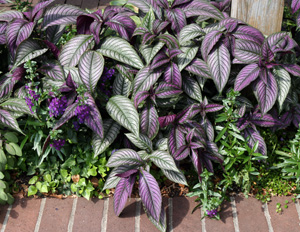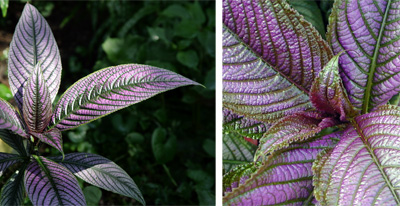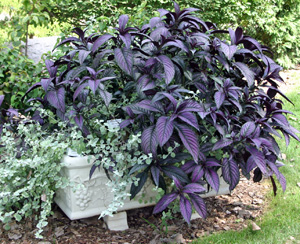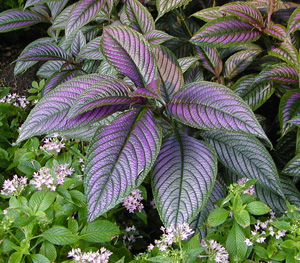
With iridescent purple leaves, Strobilanthes dyerianus is a tender perennial that makes a dramatic addition to any garden. Native to Myanmar (Burma), this evergreen sub-shrub in the acanthus family (Acanthaceae) with the common name of Persian Shield has been grown since Victorian times for its ornamental foliage indoors and out. Only hardy to zone 10 (maybe root hardy to zone 8), it is typically used as a seasonal annual or as a houseplant in colder climates.
Persian shield languishes when the weather is cool, but grows quickly under hot and humid conditions to form a large, bushy, mounded plant. This soft-stemmed herbaceous shrub can grow up to 5 feet tall and 3 feet wide, but typically remains much smaller when grown in containers or in cooler climates.

The opposite, lance-shaped leaves have lightly toothed edges and prominent veins creating an almost quilted look. The foliage is a deep purple, lilac and green overlaid with silvery highlights on older leaves, creating an unusual metallic or iridescent sheen on the upper surface. The lower leaf surface is a solid purple-maroon. Individual leaves grow 6-8″ long and develop the best color in hot conditions. As plants age, they develop woody stems and the coloration of the foliage tends to decline, so it is best to start with fresh plants or take cuttings annually to obtain the most ornamental foliage.

In mild climates, older plants produce short conical spikes of insignificant flowers held above the foliage in fall or winter. The funnel-shaped, pale blue to lilac-colored flowers are five-lobed, with two, three or four stamens. The flowers emerge from sticky brachts, opening sequentially along the spike, so the plant remains in bloom for a long time. The spent flowers turn brown after a while, so they are not particularly attractive for long. Once the plant produces spikes, floral buds arise from every node and the stems can no longer be used for propagation. Plants do not easily revert to the vegetative stage. Bud initiation is erratic and the factors that trigger reproduction are not understood.

Persian shield is a good addition to larger gardens for foliar contrast. It makes a dazzling counterpoint to variegated, lime-green or chartreuse-colored foliage. The purple foliage combines well with pink, lavender or purple flowers – such as purple flowered lantana or Verbena bonariensis – for a monochromatic look, or with yellow or orange flowers, such as Tithonia or marigolds, for high contrast. The silvery highlights on the leaves echo white flowers or white to silvery foliage, such as lamb’s ears, dusty miller or silver Plectranthus, for a more sophisticated look.

Try planting it with coleus (such as one with lime green leaves with purple veins and margin), or for a dramatic, tropical effect mix Persian shield with caladiums, elephant ears, and/or cannas. It makes a terrific addition to large mixed container plantings, where its growth is restricted, or can be used as a temporary specimen planting in the landscape or around ponds.
Plant Persian shield in full sun in more northern areas; in southern states it usually benefits from partial shade. It may be pinched back if it gets too leggy, although this is usually not an issue when grown as a seasonal annual. Provide rich soil high in organic matter, with good drainage but also plenty of water. Space plants 18-24″ apart. Fertilize monthly. Persian shield has few pests and is reported to not be favored by deer or rabbits. Indoors plants may become infested with spider mites, aphids or mealybugs. This plant can often be kept over the winter in cold climates by digging it up in the fall (well before frost) and holding it indoors in moderate light. Plants may lose all of their leaves, but should come back from the roots in the spring.

This plant is typically propagated from cuttings, but can also be grown from seed. Basal or softwood cuttings taken in early spring or summer root readily in water or moist medium. Cuttings can also be taken in late summer or early fall to bring inside to overwinter.
There are about 250 other species of Strobilanthes, including S. maculates from the Himalayas, with silver-splotched leaves and S. lactates from Brazil with white blotched leaves, but none are readily obtainable as ornamentals.
– Susan Mahr, University of Wisconsin – Madison
Ask Your Gardening Question
If you’re unable to find the information you need, please submit your gardening question here:





 Marigolds
Marigolds Create a Butterfly Garden
Create a Butterfly Garden Plant Flowers to Encourage Beneficial Insects
Plant Flowers to Encourage Beneficial Insects Forcing Bulbs
Forcing Bulbs


